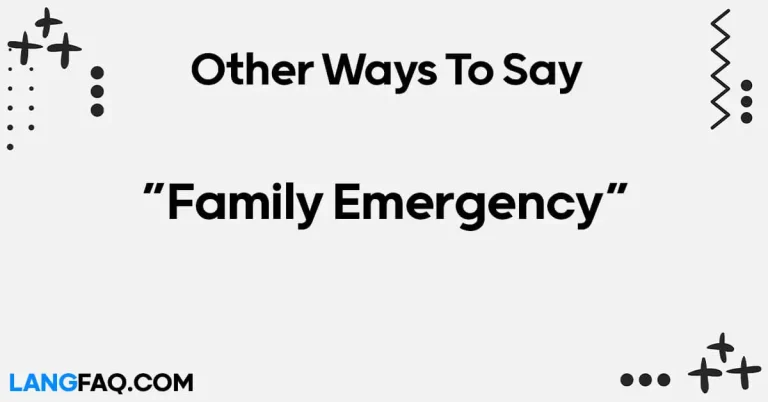Welcome to the realm of linguistic versatility! This article will unravel 12 distinctive ways to articulate “Firstly, Secondly, Thirdly.” Elevate your writing game and captivate your audience with these engaging alternatives.
12 Other Ways to Say “Firstly, Secondly, Thirdly”
Here are 12 other ways to express “Firstly, Secondly, Thirdly”:
- To start with
- To commence
- To kick things off
- In the first place
- To begin with
- First off
- For starters
- Next
- In the next place
- Second in line
- Moving on
- To cap it all
Here’s a table with meanings and examples for the 12 alternatives to “Firstly, Secondly, Thirdly”:
| Expression | Meaning | Example |
|---|---|---|
| To start with | Initiating the discussion | To start with, let’s address the main issue. |
| To commence | Beginning or starting | To commence, we need to analyze the data. |
| To kick things off | Starting in an energetic manner | Let’s kick things off with an exciting fact. |
| In the first place | Firstly, as the initial point | In the first place, consider the implications. |
| To begin with | Starting, often in a formal context | To begin with, let’s review the key findings. |
| First off | As the first point | First off, we need to understand the basics. |
| For starters | As an introductory point | For starters, let’s outline the main objectives. |
| Next | Following the current point | Discussing the results. Next, the implications. |
| In the next place | Following in sequence | In the next place, we’ll explore alternative solutions. |
| Second in line | As the second point | Second in line is the impact on our resources. |
| Moving on | Transitioning to the next point | After addressing the challenges, moving on to the opportunities. |
| To cap it all | As the final and concluding point | To cap it all, let’s summarize the key takeaways. |
Incorporating diverse expressions for enumerating ideas adds richness and variety to your writing. These alternatives provide flexibility and enhance the engagement of your audience, making your communication more dynamic and compelling.
Is It Correct to Say “Firstly, Secondly, Thirdly”?
Yes, using “Firstly, Secondly, Thirdly” is grammatically correct, and it’s a common way to enumerate or list points in writing or speaking. These words, known as ordinal numbers, indicate the order or sequence of items. However, it’s worth noting that while “firstly” is widely accepted and used, some people prefer using “first” without the “-ly” suffix, considering it a more straightforward and formal option.
Here’s a breakdown:
- Firstly: This term is an adverbial form of “first.” It’s used to introduce the initial point or step in a series of ideas or actions.
- Secondly: Similar to “firstly,” “secondly” serves as an adverbial form of “second,” indicating the second point or step in a sequence.
- Thirdly: Continuing the pattern, “thirdly” is derived from “third” and is employed to introduce the third point or step in a series.
While using “Firstly, Secondly, Thirdly” is correct and widely accepted, it’s also essential to maintain variety in your language. You can experiment with alternative expressions, as discussed in the previous sections, to keep your writing dynamic and engaging. Employing diverse language adds richness to your communication and caters to different preferences in formal and informal contexts.
Professional Mail Example With “Firstly, Secondly, Thirdly”
Subject: Proposal Review and Next Steps
Dear [Recipient’s Name],
I trust this email finds you well. I am writing to provide a comprehensive overview of our recent proposal and outline the next steps for implementation.
Firstly: Proposal Overview
In the first place, let’s delve into the key components of the proposal. We have thoroughly analyzed the requirements outlined in your initial brief and meticulously crafted a solution tailored to address your specific needs.
Secondly: Key Highlights
Secondly, I would like to highlight the key features that set our proposal apart. Our team has extensive experience in delivering similar projects, and we are confident that our approach aligns seamlessly with your objectives. Moreover, our competitive pricing ensures optimal value for your investment.
Thirdly: Implementation Plan
Moving on to the next crucial aspect, thirdly, I have outlined a detailed implementation plan. This plan encompasses milestones, timelines, and resource allocation, providing a roadmap for the successful execution of the proposed solution. Additionally, we have identified potential challenges and formulated mitigation strategies to ensure a smooth implementation process.
In Conclusion: Next Steps
In conclusion, I would like to discuss the next steps in bringing this proposal to fruition. I propose scheduling a meeting at your earliest convenience to address any queries you may have and finalize the finer details of our collaboration.
I appreciate your time and consideration. Please feel free to suggest a suitable time for our meeting, or let me know if you require any additional information.
Thank you for considering our proposal, and I look forward to the opportunity to work together.
Best regards,
[Your Full Name] [Your Position] [Your Company] [Contact Information]
To Start With: The Initiating Spark
When you’re embarking on a journey of explanation or laying out a series of points, “To start with” provides the perfect spark. This phrase signifies the beginning of a discussion, allowing you to set the tone for what follows.
When to Use:
- Formal Context: In business presentations or academic papers, “To start with” establishes a structured and organized approach.
- Informal Context: Among friends or in casual conversations, it brings a straightforward and clear beginning.
Example:
“To start with, let’s delve into the fundamental aspects of the project plan.”
Variations:
- To kick things off
- Let’s get going
- First and foremost
Email Sample:
Subject: Commencement of Project Discussion
Hi [Recipient’s Name],
I hope this email finds you well. To kick things off, I wanted to discuss the initial steps of the upcoming project. Let’s schedule a meeting at your earliest convenience.
Best regards, [Your Name]
To Commence: Beginning with Purpose
“For starters” or “To commence” adds a layer of formality to your initiation, making it suitable for situations where a deliberate and purposeful start is needed.
When to Use:
- Formal Context: Commencing a project or introducing a new agenda in a business meeting.
- Informal Context: Starting a conversation with a clear objective among colleagues or friends.
Example:
“To commence our quarterly review, let’s focus on the financial projections for the upcoming quarter.”
Variations:
- To initiate
- Let’s kick things off
- Beginning with purpose
Email Sample:
Subject: Initiating Discussion on Project Milestones
Hello [Recipient’s Name],
I trust you’re doing well. Beginning with purpose, I’d like to discuss the milestones we aim to achieve in the next quarter. Your insights are valuable. When would be a convenient time for you to meet?
Warm regards, [Your Name]
To Kick Things Off: Energetic Beginnings
Injecting energy into your narrative is crucial, and “To kick things off” does just that. This phrase is perfect when you want to start with enthusiasm and captivate your audience from the outset.
When to Use:
- Formal Context: Energizing a team meeting or launching a new project.
- Informal Context: Starting a casual presentation or a discussion among friends.
Example:
“To kick things off, let’s celebrate the successful completion of our latest project milestone!”
Variations:
- To begin with enthusiasm
- Let’s get started with energy
- Launching with excitement
Email Sample:
Subject: Exciting Launch of New Project Phase
Dear [Recipient’s Name],
I hope this message finds you in good spirits. To begin with enthusiasm, I’m thrilled to announce the launch of the next phase of our project. Your participation is key. Let’s discuss this further in our upcoming meeting.
Best regards, [Your Name]
In the First Place: Establishing Priority
When precision and clarity are paramount, “In the first place” serves as a powerful expression to underscore the initial point or priority in your discussion.
When to Use:
- Formal Context: Presenting key points in an academic paper or highlighting critical issues in a business report.
- Informal Context: Clarifying priorities in casual conversations or discussions.
Example:
“In the first place, we need to address the core challenges before moving on to potential solutions.”
Variations:
- Initially
- Firstly
- To begin with
Email Sample:
Subject: Addressing Priority Issues
Hi [Recipient’s Name],
I trust you’re well. Initially, let’s focus on addressing the priority issues highlighted in our recent report. Your insights on this matter are crucial. Can we schedule a meeting to discuss further?
Warm regards, [Your Name]
To Begin With: Starting the Journey
“To begin with” is a versatile expression that seamlessly transitions between formal and informal contexts, making it suitable for a variety of situations. This phrase is ideal for starting a comprehensive exploration of your ideas.
When to Use:
- Formal Context: Commencing a detailed analysis or discussion in academic or professional writing.
- Informal Context: Starting a conversation or explanation among friends or colleagues.
Example:
“To begin with, let’s examine the historical context before delving into the implications of the current situation.”
Variations:
- To start the journey
- Commencing with analysis
- Beginning our exploration
Email Sample:
Subject: Starting the Analysis
Hello [Recipient’s Name],
I hope this email finds you well. Commencing with analysis, I would like to discuss the initial findings of our recent market research. Your input is invaluable. Can we set up a meeting to go over this?
Best regards, [Your Name]
First Off: The Opening Move
When you want to get straight to the point, “First off” is your go-to expression. This phrase conveys a sense of immediacy and clarity, making it effective in various communication settings.
When to Use:
- Formal Context: Opening a presentation or addressing a critical point in a report.
- Informal Context: Cutting to the chase in casual conversations or discussions.
Example:
“First off, let’s address the key challenges that our team is currently facing.”
Variations:
- Starting with clarity
- To kick things off
- The initial move
Email Sample:
Subject: Immediate Attention Required
Dear [Recipient’s Name],
I trust this message finds you well. Starting with clarity, I need your immediate attention to address the pressing challenges our team is currently encountering. Let’s connect at your earliest convenience.
Best regards, [Your Name]
For Starters: The Opening Gambit
“For starters” is a friendly and approachable way to initiate discussions. Whether in a formal or informal setting, this expression eases into the conversation, making it suitable for various contexts.
When to Use:
- Formal Context: Beginning a presentation or introducing a new concept in a meeting.
- Informal Context: Opening discussions or addressing initial points among friends or colleagues.
Example:
“For starters, let’s explore the basic principles that underlie our upcoming project.”
Variations:
- As an introduction
- Commencing with the basics
- The initial point
Email Sample:
Subject: Introduction to New Project Concepts
Hello [Recipient’s Name],
I hope this email finds you well. As an introduction, I’d like to discuss the basic principles that will guide our upcoming project. Your insights on this matter are highly appreciated. Can we arrange a meeting to delve into the details?
Warm regards, [Your Name]
Next: Smooth Transition
“Next” is a straightforward yet effective transition word. Whether in a formal or informal setting, this expression guides your audience seamlessly from one point to the next, maintaining a logical flow.
When to Use:
- Formal Context: Transitioning between sections in academic writing or business presentations.
- Informal Context: Moving from one topic to another in casual discussions or presentations.
Example:
“Next, let’s examine the implications of these findings on our overall strategy.”
Variations:
- Following this
- Moving on
- The subsequent point
Email Sample:
Subject: Transition to the Next Phase
Dear [Recipient’s Name],
I trust you’re doing well. Following this, I’d like to discuss the next phase of our project. Your insights on this matter are crucial. Can we schedule a meeting to go over the details?
Best regards, [Your Name]
In the Next Place: Following in Sequence
When precision and a sense of order are required, “In the next place” is a valuable expression. This phrase is particularly useful when guiding your audience through a sequence of points or steps.
When to Use:
- Formal Context: Enumerating steps in a process or outlining sequential points in a report.
- Informal Context: Providing clear steps or instructions in casual conversations or discussions.
Example:
“In the next place, let’s delve into the specific actions required to implement these recommendations.”
Variations:
- Following this
- The succeeding point
- To proceed
Email Sample:
Subject: Next Steps in Project Implementation
Hi [Recipient’s Name],
I hope this message finds you in good spirits. Following this, I’d like to discuss the next steps in the implementation of our project. Your expertise on this matter is essential. Can we arrange a meeting to go over the details?
Warm regards, [Your Name]
Second in Line: The Follow-Up Point
When you want to emphasize a secondary point, “Second in line” provides a clear and structured way to present your ideas. This phrase is effective in various contexts, offering a concise way to introduce the next point in a sequence.
When to Use:
- Formal Context: Presenting a secondary point in academic writing or business reports.
- Informal Context: Introducing the next point in casual discussions or presentations.
Example:
“Second in line, let’s explore the potential challenges associated with the proposed strategy.”
Variations:
- The next point
- Following this
- To proceed
Email Sample:
Subject: Discussion on Secondary Points
Hello [Recipient’s Name],
I trust you’re doing well. The next point on our agenda is exploring the potential challenges associated with the proposed strategy. Your insights on this matter are crucial. Can we schedule a meeting to go over the details?
Best regards, [Your Name]
Moving On: Seamless Progression
“Moving on” is a versatile expression that signals a smooth transition to the next point in your discussion. Whether in a formal or informal setting, this phrase keeps your narrative flowing seamlessly.
When to Use:
- Formal Context: Transitioning between sections in academic or professional writing.
- Informal Context: Shifting from one topic to another in casual conversations or presentations.
Example:
“Moving on, let’s explore the practical applications of these theoretical concepts in real-world scenarios.”
Variations:
- Proceeding with the discussion
- Shifting focus to
- Transitioning to the next point
Email Sample:
Subject: Transitioning to the Next Agenda Item
Dear [Recipient’s Name],
I hope this email finds you well. Proceeding with the discussion, I’d like to shift our focus to the next agenda item. Your input on this matter is highly valued. Can we arrange a meeting to delve into the details?
Warm regards, [Your Name]
To Cap It All: The Final Touch
When you’re ready to conclude your discussion or summarize key points, “To cap it all” is a fitting expression. This phrase adds a sense of finality, making it clear that you’re reaching the conclusion.
When to Use:
- Formal Context: Concluding a presentation or summarizing key findings in a report.
- Informal Context: Wrapping up discussions or summarizing points among friends or colleagues.
Example:
“To cap it all, let’s summarize the main takeaways from our discussion and explore potential action points.”
Variations:
- In conclusion
- To summarize
- Wrapping it up
Email Sample:
Subject: Conclusion and Next Steps
Hi [Recipient’s Name],
I hope this message finds you in good spirits. In conclusion, I’d like to summarize the main takeaways from our recent discussion and explore potential action points. Your insights on this matter are crucial. Can we schedule a meeting to go over the details?
Best regards, [Your Name]
FAQs:
What are some casual alternatives for “Firstly”?
Explore more laid-back options like “First off,” “To kick things off,” or “For starters.”
Can I use these alternatives in formal writing?
Absolutely! While some are more formal, many alternatives suit both casual and formal contexts seamlessly.
How do I choose the right alternative for my writing?
Consider the tone and formality of your piece. Experiment with different alternatives and choose the one that best fits the context.
Are these alternatives suitable for academic essays?
Certainly! Diversifying your language enhances the quality of your academic writing, making it more engaging for readers.
Can I mix and match these alternatives in a single piece?
Certainly! Using a variety of expressions adds dynamism to your writing, keeping your audience interested.
Any tips for seamlessly integrating these alternatives into my writing?
Practice is key. Experiment with different alternatives in your drafts, and soon you’ll master the art of seamless integration.
Conclusion:
Congratulations! You’ve now expanded your repertoire of expressions for enumerating ideas. Experiment with these alternatives, and watch your writing transform into a captivating and persuasive masterpiece.







